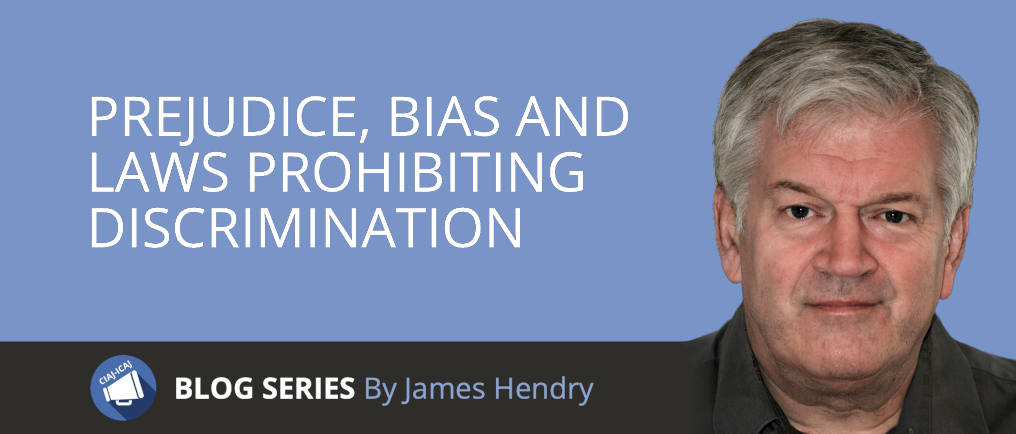Prejudice, Bias and Laws Prohibiting Discrimination

This blog post is part of a series on “SCC Decisions and more” written by CIAJ’s collaborator James Hendry. Read all his posts here.
The Supreme Court of Canada has recognized that subjective assumptions, prejudice, ignorance and biases about individuals’ personal characteristics have historically structured the distribution of many important public and private benefits. This has resulted in unjustifiable disadvantages for members of certain disadvantaged groups (for example, here, paras. 25-40).
Section 15 of the Charter and anti-discrimination law in every jurisdiction aim at eliminating discrimination. The same goal can be found throughout our legal system. The Court has held that a collective agreement has a public dimension that makes the rights of the parties subject to anti-discrimination law (here). This goal also extends to legal practitioners. The Model Code of Professional Conduct developed by the Federation of Canadian Law Societies suggests an ethical code should prohibit lawyers from discriminating against any person (here Rule 6.3).
Laws meant to eliminate discrimination will achieve their goal to the extent their evidentiary requirements are sensitive enough to expose and remedy them. The effectiveness of these protections depends in part on whether they aim at discriminatory intent or its effects. An exploration of the prejudices and biases motivating a discriminatory decision would be hard to prove and is more suited to punishing the alleged discriminator. Evidence of the effects of a decision on members of a group based on shared personal characteristics would be more readily available. It would demonstrate whether the decision was based on immutable characteristics that are often based on subjective stereotypes and not merit (here, para. 13, here, paras. 61-7). These historic patterns of discrimination will have a historical context of prejudice and cognitive bias.
In two relatively early cases, the Court significantly extended the potential efficacy of anti-discrimination laws by defining the evidentiary basis of proof of discrimination. The question before the Court was whether the focus of anti-discrimination law should be on the intent of the person alleged to have unlawfully discriminated or on the effect of that decision on the person(s) negatively affected by it. The Court decided that it must focus on the effects of private and public decision-making on members of protected groups (here and here). The most relevant evidence would be about the effects of decisions that adversely affected persons based on their personal characteristics. This avoided the moral overtones of having to prove malice and extended protection to unforeseen impacts on disadvantaged groups (see here at 1135).
These decisions made evidence of intention to discriminate unnecessary. However, seemingly neutral policies and decisions might also be discriminatory proved by evidence exposing the subjective biases and prejudices underlying them. Pervasive bias might be embedded in the decision-making of government, service provider or employer revealing systemic discrimination. In one case, the CN Railway had carried out a review of its employment practices of women filed as evidence in a complaint of sex discrimination in the disproportionately low hires of women in entry level labourer jobs compared to men. The report catalogued sexist attitudes throughout the company embedded in hiring policies and related actions explaining the low number of women hired for non-traditional jobs. The Court upheld the affirmative action remedy ordered by the human rights tribunal (here).
Discriminatory assumptions might also come to light in the justifications offered for impugned decision-making. Justification under anti-discrimination legislation and the Charter aims at objectivity (anti-discrimination legislation here, at 208, Charter see here, para. 36).
Remedies for discrimination under legislation included programs aimed at challenging and discouraging negative subjective practices and attitudes and eliminating undesirable conditions (see here at 1139ff. and here, para. 15)
The Court decided in 1989 that the constitutional protection against discrimination in governmental action would also focus on the negative effects on vulnerable groups whose personal characteristics are protected by s. 15 of the Charter (here). Thus, a study of those prejudices and cognitive biases would help explain much of discrimination and make remedies more effective (see here, para. 57). However, even if the reasons for such skewed decisions are not precisely known, significant statistical and historical disparities in the allocation of benefits and burdens to members of groups with common personal characteristics will show that a member or members of a protected group has been treated contrary to their real needs and circumstances (see here, paras. 62-3).
By contrast to the Canadian approach, the Supreme Court of the United States decided that proof of discriminatory intent was required to establish a breach of the constitutional rights to equality. The court reasoned that finding a breach based on evidence of adverse effects (“disparate impact” in the US) could subject too much legislation to scrutiny (here, para. 21). Only a few protective statutes, such as the Civil Rights Act, can be proved by evidence of disproportionate effects of a facially neutral policy on a vulnerable group (here). Various NGOs are trying to get the courts to extend the effects-based approach to discrimination (here).
The ubiquity of legal prohibitions of discrimination in Canada makes the elimination of direct and adverse effect discrimination part of the ethical structure of the rule of law in Canada. It also suggests that further study of the prejudices and cognitive bias of those making decisions about allocation of public and private benefits would increase the sensitivity of the law.
***Not for use as legal advice

